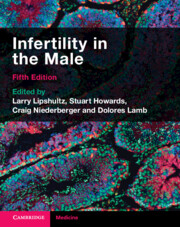Book contents
- Infertility in the Male
- Infertility in the Male
- Copyright page
- Contents
- Contributors
- Foreword
- Abbreviations
- Introduction
- Section 1 Scientific Foundations of Male Infertility
- Chapter 1 Anatomy and Embryology of the Male Reproductive Tract and Gonadal Development, the Epididymis, and Accessory Sex Organs
- Chapter 2 Cellular Architecture and Function of the Testis
- Chapter 3 Maturation and Function of Sperm
- Chapter 4 The Male Reproductive Endocrine System
- Chapter 5 Erection, Emission, and Ejaculation
- Chapter 6 Genomics, Epigenetics, and Male Reproduction
- Section 2 Clinical Evaluation of the Infertile Male
- Section 3 Laboratory Diagnosis of Male Infertility
- Section 4 Treatment of Male Infertility
- Section 5 Health Care Systems and Culture
- Index
- References
Chapter 1 - Anatomy and Embryology of the Male Reproductive Tract and Gonadal Development, the Epididymis, and Accessory Sex Organs
from Section 1 - Scientific Foundations of Male Infertility
Published online by Cambridge University Press: 08 July 2023
- Infertility in the Male
- Infertility in the Male
- Copyright page
- Contents
- Contributors
- Foreword
- Abbreviations
- Introduction
- Section 1 Scientific Foundations of Male Infertility
- Chapter 1 Anatomy and Embryology of the Male Reproductive Tract and Gonadal Development, the Epididymis, and Accessory Sex Organs
- Chapter 2 Cellular Architecture and Function of the Testis
- Chapter 3 Maturation and Function of Sperm
- Chapter 4 The Male Reproductive Endocrine System
- Chapter 5 Erection, Emission, and Ejaculation
- Chapter 6 Genomics, Epigenetics, and Male Reproduction
- Section 2 Clinical Evaluation of the Infertile Male
- Section 3 Laboratory Diagnosis of Male Infertility
- Section 4 Treatment of Male Infertility
- Section 5 Health Care Systems and Culture
- Index
- References
Summary
To understand the range of male infertility conditions, knowledge of normal male anatomy and its embryology is essential. This chapter will review the major developmental events from fertilization to organization of the germ layers into organ systems. It will review in depth the formation of the male genitourinary system and external genitalia. By laying a strong foundation in embryology and anatomy, providers will have a more thorough understanding of disease states.
- Type
- Chapter
- Information
- Infertility in the Male , pp. 5 - 16Publisher: Cambridge University PressPrint publication year: 2023



